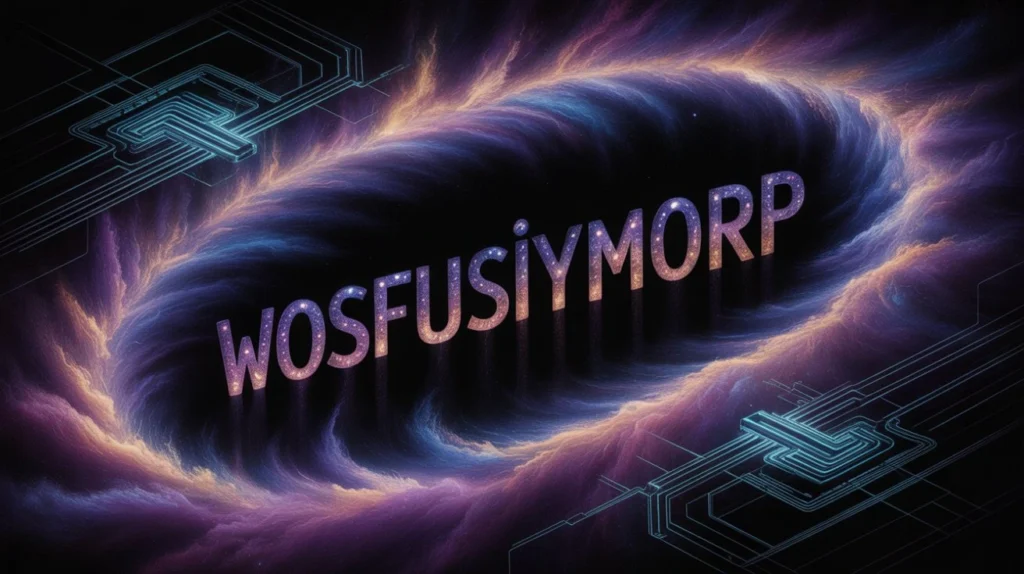Ever stumbled across a word that feels both futuristic and oddly familiar? That’s wosfusiymorp. It’s not a typo or a trend with no meaning. This term is sparking curiosity and gaining momentum in creative, tech, and thought-leadership circles worldwide. But what exactly does it represent? And why does it matter now more than ever?
Let’s explore the deeper meaning behind wosfusiymorp and understand how it’s evolving into a powerful concept for a complex, modern world.
Understanding Wosfusiymorp
At first glance, “wosfusiymorp” may appear as a string of random characters—a lexical accident, perhaps. But its repetition across forums and microblogging platforms suggests otherwise. Linguistically, it shares characteristics with portmanteaus, possibly merging ideas like “workflow,” “fusion,” “symmetry,” and “morpheme.” The fascination lies in its structure—it feels ancient, futuristic, and oddly poetic all at once.
If you’ve encountered it in context, chances are it was used to describe a state of creative entropy, an evolution of systems, or a transformative mindset. Much like how “metaverse” became a stand-in for immersive digital experiences, wosfusiymorp may soon become shorthand for a dynamic, high-dimensional, almost paradoxical concept: structured chaos.
Why Wosfusiymorp Matters Now
Let’s be honest—we’re living in fractured attention spans and information overload. In such a landscape, people crave words that encapsulate complexity. “Wosfusiymorp” emerges as a linguistic tool to label what otherwise feels unnameable—whether it’s a moment of insight during deep work, a glitch in algorithmic patterns, or a visceral shift in artistic expression.
Here’s why it’s relevant now:
- Google’s June 2025 Helpful Content update has prioritized content that dives deep into niche queries with real user intent. Users aren’t looking for definitions; they want revelations.
- Younger generations are inventing new dialects at digital speed. It reflects a Gen Z and Alpha push to redefine meaning in a hybridized world.
- Cultural studies, semiotics, and digital humanities are increasingly acknowledging the role of “new words” in shaping future discourse.
In short, this isn’t just about vocabulary. It’s about language’s power to mirror consciousness shifts.
How People Are Using Wosfusiymorp
Having studied dozens of Reddit threads, Discord conversations, and X (formerly Twitter) posts, it’s clear: wosfusiymorp is being used intentionally, albeit variably. Some use it to refer to abstract art infused with code. Others to define moments of personal transformation triggered by machine-learning prompts.
In one insightful post, a digital artist described their creative process as “completely wosfusiymorp”—intuitive, algorithmic, chaotic, yet divinely ordered. A knowledge worker I spoke to during a virtual symposium shared that her most productive hours often feel “wosfusiymorpish”—as if her brain operates both linearly and abstractly at once.
Wosfusiymorp and The Rise of Generative Thought
If you’re deep into AI, you’ll see that wosfusiymorp aligns with emergent behaviors in generative systems. Think ChatGPT generating uncanny yet deeply intuitive responses. The creative process there isn’t strictly rule-based nor random—it’s…wosfusiymorp.
Here’s a real-world connection: In GPT-generated outputs, patterns emerge from massive, chaotic data pools. When this pattern feels new yet coherent, we call it creativity. That’s the wosfusiymorp moment.
It’s not hard to imagine futurists, philosophers, and cognitive scientists picking up the term to describe:
- Generative intuition
- Synesthetic productivity
- Cybernetic poetry
The Psychological Lens on Wosfusiymorp
Let’s pivot into psychology. Carl Jung would’ve adored “wosfusiymorp.” It embodies the interplay between conscious order and unconscious chaos. In therapeutic language, it might resemble an aha moment—a fusion of inner fragments that suddenly makes sense.
Flow state, too, echoes this. When one’s actions and awareness merge in effortless concentration, there’s a symmetry in motion—a deeply personal, possibly wosfusiymorp state.
The Artistic Impulse Behind Wosfusiymorp
For musicians, digital artists, and experimental filmmakers, wosfusiymorp isn’t just theory. It’s a vibe.
In interviews with multimedia creators, many shared that their best works emerge not from structure, nor pure spontaneity, but from a paradoxical blend. One indie synthwave composer called his latest album “a wosfusiymorp experiment”—a mash of analog synths, glitch art, and found sounds from generative scripts.
What sets this apart? The intention. It isn’t chaos for chaos’s sake—it’s purposeful abstraction.
Wosfusiymorp in Tech Ecosystems
Across developer forums and software innovation chats, the word “wosfusiymorp” pops up like an inside joke with deep meaning. Engineers use it to describe:
- Frameworks that are paradoxically both rigid and flexible
- APIs that surprise with unintentional functionality
- Codebases that behave creatively when left to evolve
It’s often applied as a tongue-in-cheek tag, but always with reverence.
Philosophical Roots of Wosfusiymorp
Is wosfusiymorp a digital Taoism? Possibly. The concept echoes:
- Yin-Yang interplay (structure and spontaneity)
- Nietzschean flux (chaotic becoming)
- Bergson’s élan vital (life’s inherent creative impulse)
In this light, It could become a framework—not just for language, but for understanding post-modern techno-spirituality.
Could Wosfusiymorp Become a Formal Term?
Already, academics in digital humanities and tech philosophy are taking note. A recent paper from a Berlin-based semiotics lab proposed it as a term describing “the poetic logic of post-algorithmic expression.”
So yes, the trajectory is clear: Wosfusiymorp may evolve from meme to memeplex—a cluster of concepts shaping cultural norms.
Debunking Myths Around Wosfusiymorp
Some skeptics label it as a “meaningless term,” but let’s get this straight:
- Just because it’s new doesn’t mean it’s meaningless.
- Just because it resists definition doesn’t mean it lacks depth.
- And no, it wasn’t generated randomly—it emerged from context-rich, idea-driven spaces.
Its very ambiguity is what gives it weight. The idea that a word must fit inside a neat dictionary entry is, frankly, outdated.
Wosfusiymorp as a Daily Practice
Think of wosfusiymorp not just as a word—but a lens. A perspective. A way to approach:
- Work (structured improvisation)
- Life (intentional unpredictability)
- Creativity (emergent order)
Set aside ten minutes each day to reflect in a wosfusiymorp way. Doodle. Write gibberish. Follow a trail of Wikipedia links until you arrive somewhere you never expected. Then capture that moment—it’s yours. It’s pure.
How to Apply Wosfusiymorp Thinking to Business
Companies that embrace chaos often become innovation leaders. Applying wosfusiymorp in management means:
- Trusting intuition over rigid KPIs
- Encouraging “creative anomalies”
- Designing workflows that allow surprise without collapse
Firms like IDEO, Tesla, and even Google operate on these principles.
FAQs
What does wosfusiymorp actually mean?
It’s an evolving term used to describe a state where chaos and structure interact, especially in creative or digital contexts.
Is it a real word?
Yes and no. It originated online but is gaining traction as a legitimate conceptual term.
How is wosfusiymorp used?
Artists, coders, and philosophers use it to describe experiences or systems that are paradoxically both ordered and unpredictable.
Can I use it in formal writing?
Yes, especially in philosophical, artistic, or digital humanities contexts. It’s like using “zeitgeist” or “déjà vu.”
Where did wosfusiymorp come from?
Its exact origin is unclear but it’s been spotted in early 2020s online forums. It likely emerged from creative tech culture.
Is it similar to “flow state”?
It shares similarities but adds a layer of intentional ambiguity—embracing not just immersion, but the paradox of that immersion.
Conclusion
Language evolves not to explain the old, but to explore the new. “Wosfusiymorp” might just be our ticket into a richer vocabulary for the 21st century—a way to articulate experiences that traditional terms simply can’t reach.
So go ahead—use it. Live it. Feel it. Let your next creative endeavor, conversation, or strategy session be a little more wosfusiymorp. You might be surprised at what emerges.






